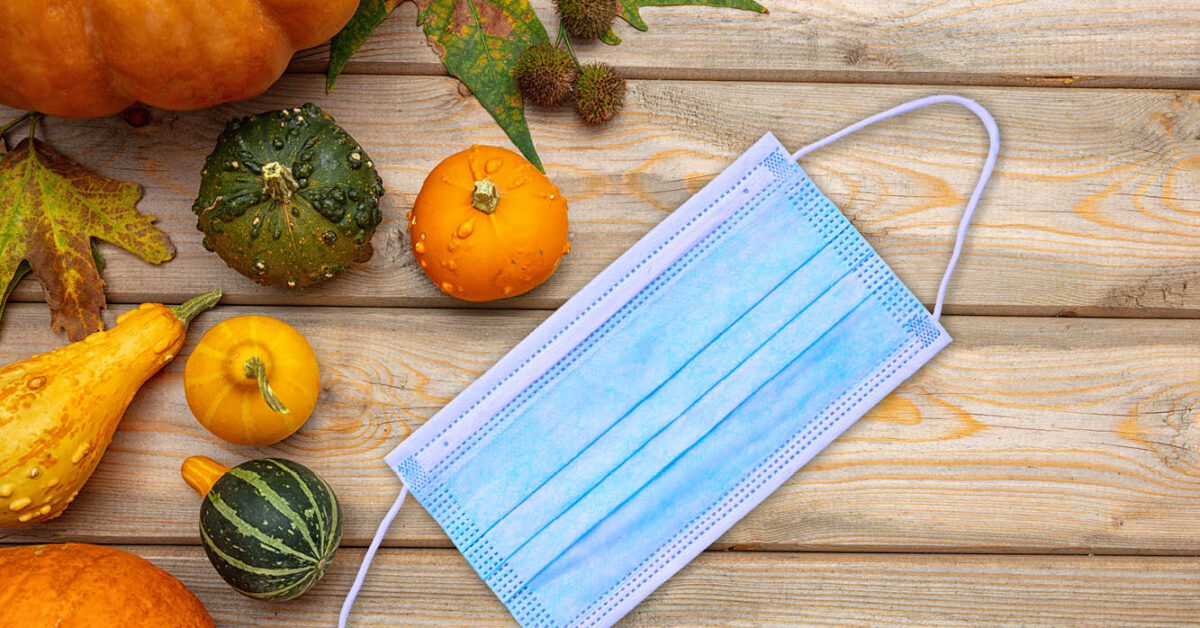
Plastic Surgery—Is it Right for You?
November 2021
Business Blueprint
November 2021Research shows that the holidays can be hard on our health, both physically and mentally. A study reported in the journal Circulation reports that cardiac-related deaths are higher from Thanksgiving through New Year’s than any other time of year. Accidents increase, whether from chopping down a tree or hanging lights from the highest roof line. We drink too much and overeat and gain weight. The stress of the holiday season can lead to depression and negatively affect our mental health. In this special section on Staying Healthy Over the Holidays, we encourage people to take care of themselves while enjoying the merriment with stories on how to manage diabetes, deal with grief, pamper their feet after all the mall-walking, even a piece on caring for teeth and braces in the face of all those sweets!
How to Avoid, Identify, and Treat COMMON COLDS and FLU
Levels of the common cold and influenza (aka the flu) hovered at historic lows during most of 2020, according to a report from the Centers for Disease Control and most likely due to mask wearing and social distancing measures. But as COVID-19 restrictions continue to lift, we may see a resurgence of colds and flu this fall and winter. In addition to chicken noodle soup and plenty of Kleenex, arm yourself with the following information to avoid, identify, and treat cold and flu symptoms.
What can you do to prevent the cold/flu? The common cold or flu is spread by direct contact with the virus which is transmitted by other infected persons. Avoid public places, cover coughs and sneezes, wash hands routinely, and avoid touching common objects in public places such as restroom fixtures (use a paper towel), counters, and keyboards. Avoid touching your face without first washing your hands. Physical activity helps boost your immunity and keeps your heart pumping and blood flowing to better combat viruses. Eat more dark green leafy vegetables, red and yellow veggies, and more fruits to help build antioxidant phytochemicals to fight off the virus.
Is it a cold, flu, or allergies? Sometimes it can be difficult to tell if symptoms are from a common cold, a virus, or from allergies. The body reacts similarly to both common cold and allergies, but some of the differences are how long the symptoms last, the time of year, and time of onset of symptoms. Allergies can occur any time of the year and can last anywhere from a few days to months and start immediately after exposure to the allergen that may affect you such as seasonal allergies, pet fur/dander, or dust and mold. Allergies most commonly cause runny or stuffy nose and itchy watery eyes. Sometimes allergies may cause a sore throat and fatigue, but rarely will they cause aches and pain in muscles. The common cold generally will not last longer than 10 days, occurs most often in late fall and winter and may take a few days after exposure before symptoms present. Colds generally causes a cough, sore throat and runny or stuffy nose. It can sometimes cause fatigue and aches and pains in muscles. Flu is similar but usually is accompanied by fever.
How to sleep with a stuffy nose? Buy a Neti pot kit at your local drug store and follow directions to make a lukewarm saline nasal rinse just before bedtime. Take a hot, steamy shower or sit in the bathroom with hot water running to allow steam to loosen mucus in sinuses. This will help drain and alleviate pressure. Drinking hot broth, soup or drinking hot tea will help alleviate stuffiness by reducing swelling in membranes. Avoid alcohol and caffeine prior to bedtime. Elevate your head while trying to sleep.
Managing Grief over the Holidays
by Angie Kay Dilmore
Grief is not a topic most people like to talk about. Whether prompted by the death of a loved one, divorce, or any life event that breaks your heart, learning how to deal with grief is a first step in ultimately overcoming the sorrow.
Victoria Ellender, a local public relations professional, knows a lot about grieving. Her mother, Cheryl Garner-Hartley, died of metastatic breast cancer at the age of 49 in 2016. Three years later, Victoria’s 24-year-old sister, Madeleine, died tragically while on a vacation in Mexico. As the oldest of six children, Victoria says the ramifications of losing their mother prematurely caused many other difficult circumstances and events to occur. “Mom died much earlier than expected. With no family history of cancer, her loss was jolting. It redefined everything we knew and could expect for our future.”
On the very day her mother was diagnosed with cancer, Victoria discovered she was pregnant with her fourth child. Despite pregnancy and later parenting four children under the age of five, Victoria supported her mother through her valiant battle against the disease. “Grief can be especially difficult for caregivers,” she says. “I developed some long-term consequences from living in that level of survival mode for so long. It delayed my grieving process. It took more than a year for me to reach an equilibrium after living under that level of high stress. By then, I was finally ready to do some grief work, and that’s when people told me I should be over it. But, no. I shouldn’t have been.”
While being mindful of the five stages of grief, Victoria says she learned to not compare her grief with others. “Every relationship is unique and every loss—no matter how or when it happens—is uniquely our own. I learned much about grief through the loss of my mom. When my sister died, I was much better equipped to handle it. My sister’s death was traumatic. Gut-wrenching. And the hardest part was watching my siblings and dad go through another loss. Madeleine was a beautiful soul. I also learned how incredibly unique each of us is through the loss of her. We are all uniquely irreplaceable. There is no one else like Mom. No one else like Madeleine.”
Victoria admits, grief can be particularly difficult over the holidays. “For me, the days and weeks leading up to holidays are worse than the anniversaries of their deaths. Because I know what’s coming, I do a lot of my grief work in advance. I find that we can endure just about anything if we prepare for it. I take a lot of time for myself in the days leading up to holidays. I drop my self-expectations. I allow myself to just be. I also create boundaries with other people who don’t understand. We put so much pressure on ourselves and on others to act normal, to be happy. But everyone’s grief is unique. For some, keeping traditions alive is how they cope best with grief. Others prefer to skip the traditional stuff and go to Cracker Barrel instead. For me, I try to avoid the festivities and keep things low key.”
There is no way to describe how pervasive grief is until you’ve been through a loss, says Victoria. “It affects the way you see the world. The days are long, and everything feels cold and dark.” Yet she continues to do the hard work to come to grips with her grief. She finds solace in counseling and recommends a grief recovery support group called Griefshare. She intentionally incorporates grief into her life. “I do not want to bury my pain or numb out. I know I would be worse off if I tried to ignore it. So I face it directly and intentionally.” She also reads books on grief, keeps a journal, and shares her experiences. “Telling my story is cathartic. It helps me to get my words out. Oftentimes, I don’t make connections until I say things out loud to another person. That’s how I am wired. I think we all are wired for connection.”
“I have learned so much from grief,” Victoria adds. “I am deeply grateful for my journey. Of course, I would never wish for these losses, but I am thankful for the lessons. I believe each of us has our own unique path to walk in this life. Every person has a different purpose on this earth. Reaching a place of acceptance in my purpose—that pain is a major theme in this chapter of my story—has brought healing. These losses have transformed me and allowed me to access places I didn’t know existed. It’s like I’ve been granted a portal into the trenches of pain and loss. My path has been filled with people who hurt like me, and I have been able to understand—truly understand—their broken hearts. Being able to look someone in the eyes when they’re hurting and not flinch or turn away . . . my experiences have given me that. And I am so thankful. In essence, recognizing my purpose and having faith in its meaning is what gets me through my grief.”
Ellender offers the following advice for those grieving during the holidays:
Don’t worry about how other people respond. Give yourself and others grace. Take it hour by hour, minute by minute. Don’t force yourself to smile if you don’t want to. Do not allow others to rush you. Your path is your own. Your heart and mind know what you need to heal. If you’re a planner, plan ahead. If plans overwhelm you, don’t plan. If you want to be alone, be alone.
If you’d rather be busy, stay busy. Do what you need to find peace in each moment.
Dealing with your Diabetes at Holiday Gatherings
by Emily Clyde, MS, RD, LDN
‘Tis the season for festivity, family, and food—LOTS of food. Social events and family gatherings during the holidays are often primarily centered around all things food and drink related. Since healthy eating is one of the best tools for managing blood glucose levels, the holiday season can be a challenging time for those living with diabetes. Adequate control of their blood glucose levels over time is crucial for appropriate management of their condition. In diabetics, high blood glucose levels can lead to long-term complications if left uncontrolled, such as nerve damage, vision problems, circulation issues, heart disease, and kidney disease. Hemoglobin A1C level serves as a long-term indicator of how blood sugar levels are running. This is why a primary goal for many diabetics is to prevent their A1C level from raising. Low blood glucose levels can potentially cause short-term complications, such as weakness and dizziness; thus, the importance of adequate blood glucose control. By planning ahead, a patient with diabetes can keep their diabetes management on track during the holiday season.
November is National Diabetes Month and here are a few tips on how diabetics can best manage their chronic condition during the holidays:
First and foremost, plan to stay on top of your blood sugar level. Checking it more often during the holidays is a good idea since your daily routine will differ from the usual. A common mistake diabetics make during the holidays is skipping their usual mealtimes to “save up for a feast later on.” Doing this may make it harder for the diabetic to manage their blood sugar level. Skipping a usual mealtime can place a diabetic at risk for having low blood sugar. And once they do consume the holiday meal, they’re more likely to overindulge, which in turn causes a large spike in blood sugar levels.
Try to eat close to your usual mealtimes to help keep your blood sugar steady. For instance, if your holiday meal is served later than usual, eat a small snack at your usual mealtime and eat a little less when dinner is served.
Account for serving size amounts of carbohydrate sources in holiday meals to stay on track and adhere to your diabetes management plan. Starchy, carbohydrate-rich sources include breads, rice, potatoes, and sweets. Plan to eat around the same amount of carbohydrates that you normally would for a meal. Incorporate as much nutrient-dense and colorful fruit and vegetables choices as you can in your holiday meals. Raw, grilled or steamed fruits and veggies are a great source of vitamins and minerals, are high in fiber, and may help you feel full longer on fewer calories. Go ahead and enjoy your favorites and pass on the options you’re not too crazy about. Choose the holiday dishes you really love and can’t get any other time of the year, like your relative’s famous pumpkin pie. Have a reasonable portion and enjoy it without any guilt.
Lastly, find opportunities for activity throughout holiday celebrations. Even if the activity is something as simple as a 15-minute walk, exercise is a great way to lower blood sugar levels.
‘Tis the season for celebrating, reconnecting, and spending time with your loved ones. Focus less on food, and more on enjoying precious time with friends and family!
Emily Clyde is a Wellness Registered Dietitian at Lake Charles Memorial Hospital.
Healing Foot Pain Brings More Vitality
by Christine Fisher
Aching feet are certainly nothing new, especially after long hours of standing and walking. However, when the ache continues for a long time, or is especially painful, it could indicate a problem.
While many types of arthritis can exist in the foot and ankle, osteoarthritis is the most prevalent. Commonly referred to as the “wear and tear” disease, osteoarthritis is joint breakdown over long periods of time.
“Our joint surfaces are made of a shock absorbing force called cartilage. Cartilage is what allows our joints to move freely and without pain. When this is compromised, even slight movement can become very painful. This leads to patients limiting their movement to avoid the pain, and the end result is a stiff, non-functioning joint. The joints of the ankle and great toe are common areas where we see this occurring,” explains Christine Palma, DPM, podiatric surgical specialist with Imperial Health.
Symptoms of foot and ankle arthritis include:
• Tenderness when the joint is touched
• Pain during movement
• Trouble walking or putting weight on the foot
• Joint stiffness, warmth or swelling
• More pain and swelling after resting, such as sitting or sleeping
Although there is no cure for osteoarthritis, there are a variety of treatment methods available. Some of these include anti-inflammatory medications, steroid injections, custom bracing, and surgery.
“We have a variety of options available, depending on each patient’s situation. We don’t want them to live with pain when it can be avoided, and we will work to keep them active,” Dr. Palma says.
To schedule an appointment with Dr. Palma, call (337) 312-8120. She accepts all major insurance and Medicare.
Don’t Take a Holiday from Orthodontic Care
Tips for Enjoying Seasonal Favorites with Brace
by Kristy Como Armand
The two most food-focused holidays of the year are right around the corner: Thanksgiving and Christmas. There are plenty of tempting treats to enjoy during the holiday season, but if you’re wearing braces, you’ll likely need to make some adjustments.
According to Dr. Craig Crawford, orthodontist with Crawford Orthodontics, taking care of your braces during the holiday season requires some awareness of foods that pose a risk, but that doesn’t mean you can’t enjoy holiday flavors. “Basically, the same general rules you were given when you got your braces regarding foods to avoid still apply. What you don’t want is for the holidays to set back your treatment time, or even worse, result in damage to your braces that causes pain or an orthodontic emergency during the holidays.”
Dr. Crawford offers the following guidelines for caring for your braces during the holidays:
Brushing: After each meal and before bedtime, brush your teeth and braces with a toothbrush and fluoride toothpaste. There are special toothbrushes for braces called “interdental toothbrushes” that help get to those hard-to-reach places like under wires, between brackets and in the back of your mouth.
Flossing: Floss after each meal, or at a minimum of twice a day. Floss the areas between your teeth — even the hard to reach places. Floss threaders can make navigating between the brackets and around the braces easier.
Elastics: If you have these, you should wear them as your orthodontist prescribed. The only time you shouldn’t wear them is when eating and when brushing your teeth. Make sure you have the correct elastic size as well as some extras just in case you misplace them. Now wearing your elastics could increase the risk of your teeth shifting, which would prolong treatment.
Travel Kit: If you travel during the holidays, pack a braces care kit. Include a small toothbrush, floss, mouthwash, wax, elastics and a mirror to check your smile. These are great for the car, backpack, bag, or purse. This is a good kit to keep with you even if you aren’t traveling, for times you will be away from home at holiday festivities for an extended length of time.
Eat Slowly and Carefully: Cut your food into bite-sized pieces before chewing them slowly and carefully. This is always good advice for anyone with braces, but is even more important during the holidays, when you may be eating food that is not as familiar as your normal diet.
Keep your Orthodontic Appointments: The holiday season is hectic and it can be tempting to skip an orthodontic appointment, but it’s important to remember that adjustments and examinations are important for making sure your treatment is still on track.
“The holidays are meant to be enjoyed by all, even if you are undergoing orthodontic treatment,” says Dr. Crawford. “By following just a few preventive guidelines, you can avoid problems and keep your new smile moving in the right direction.”
For more information about orthodontic options and care, call Crawford Orthodontics at (337) 478-7590.
Bah Humbug! Holiday Foods to Avoid if you have Braces
While you can still enjoy many seasonal favorites, such as turkey, ham, sweet potatoes, stuffing, mashed potatoes, pumpkin pie, bread pudding and more, there are some traditional holiday foods that could cause problems for braces. Here’s a list of some foods to avoid if you have braces this holiday season:
• All nuts
• Peanut brittle
• Pecan pie
• Gingerbread cookies
• Taffy
• Popcorn
• Seeds
• Raw, crunchy vegetables
• Fruit cake
• Caramel
• Sticky treats
• Crunchy snacks
• Candy canes
• Hard candy
• Jerky
• Hard bread






